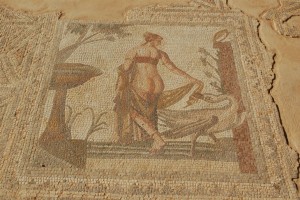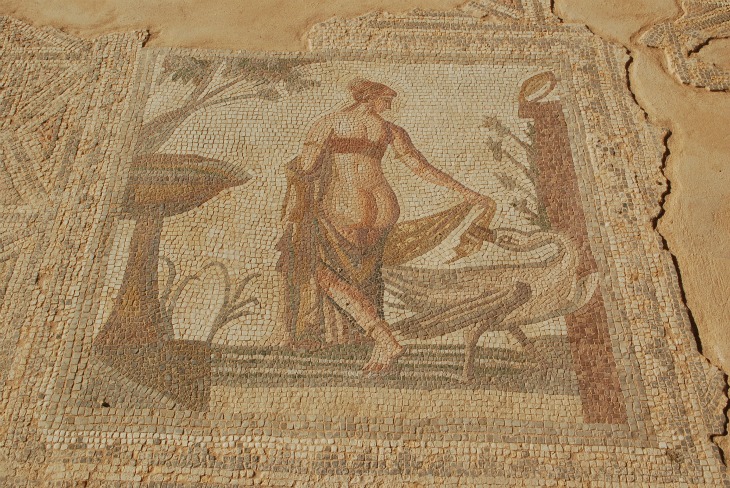“Welcome to the land of Aphrodite, Goddess of Love.”
Everyone, everywhere in Cyprus, will at some point mention the goddess, be it to sell you a villa or a bottle of wine. I challenge you to name more heavily marketed deity. But there’s nothing new under the heavens and when it comes to exploiting the famously sexy lady, the ancients were equally adept. Thanks to establishing the island as a cult centre for Aphrodite, thousands of pilgrims from all over the eastern Mediterranean were drawn to the festivals held in her name, including the four day long Aphrodisia.
We might think of it as sex tourism but to the pagan societies of the period, the fornication, rituals and orgies conducted in the name of Aphrodite were sanctified as well as advantageous.
Sacred prostitution, mentioned in the Golden Bough, placated the gods and protected the land from famine and drought by activating the reproductive forces of nature. Stass Paraskos, author of Aphrodite, The Mythology of Cyprus, paints an interesting picture of Paphos, a city on the west coast, which was the centre of the cult.
“The women of Paphos served in the Temple celebrating the union of Aphrodite and her lover Adonis at the beginning of spring. They wore special head scarves and sat in a line waiting to be chosen. Men paraded up and down and when a woman took his fancy, they threw a small silver coin in her lap. The women had no right to refuse.”

While most of these girls came from the lower classes, (some were slaves given to the temples by rich merchants) high class women served the temples, too. In fact long after the pagan period, the women of Cyprus had a reputation for offering sex to strangers. It’s a long cry from the morals of today. And so is the Paphos area.
But even in the 21st century, Cypriots are so under Aphrodite’s spell that they tell you in all sincerity that she was born off the coast of Paphos. An obligatory stop on tourist routes is accompanied by the advice to “take camera”. I’m told that if you swim around a rock you will find true love, but the buses make sure that you don’t stop for that long. Click and it’s off again to the ruins of her temple.
The most famous representation of Aphrodite’s birth is that painting by Sandro Botticelli with the shell born blonde being blown ashore by zephyrs while a nymph rushes to clothe her naked beauty with a billowing flower woven cloak of silk. Fall under its spell sometime, it’s simply beautiful.
Poor Aphrodite was later forced to marry a metal worker called Hesperus, a nice bloke but ugly and lame. She was frequently unfaithful to him. Her many lovers included the troublesome God of War and the beautiful Adonis, who was killed by Ares in the woods above Paphos where he and Aphrodite – against her better instincts (she was an early environmentalist) – hunted wild boar.
The hills today resound not with the sound of hounds and cymbals but the quiet thwack of golf clubs:AphroditeHills is a resort based around an Intercontinental hotel. It’s nice; you could take the kids there and be blissfully unaware that the area was once famed for its prostitutes and orgies.
Few guide books on Cyprus, including Paphos, Land of Aphrodite, by Renos Lavithis, dwell too much on this aspect of the goddess cult. It will hardly do since Paphos is aspiring to be the 2017 European City of culture.
At first sight this seems improbable. Modern Paphos, on the surface, has few charms. It is awash with the sort of detritus found on most Mediterranean shores like glass bottom boats and cheap trinket shops and its architecture is of an astonishing banality.
In its heyday, from 1200 BC to 400 AD, Paphos was a hugely important centre of commerce and power and during Roman times it became the capital of the island. Successive ferocious earthquakes have destroyed almost every trace of this great age and today temples, palaces and villas are nothing but ruins.
But there are some things that even earthquakes can’t destroy and at Paphos harbour, where a giant Roman city was built, some of the most important mosaic floors in the world remain. Excavations of the area, now a World Heritage Site, have uncovered a series of tile “carpets” depicting scenes from Greek and Roman mythology as well as some purely geometric patterns exactly like modern kilims. Don’t pass up the chance to see them as I once did, after the let down of paying £12 to see a tiny one at the Roman villa in Chichester.
But of Aphrodite, or as the Romans called her Venus, there is only a single mosaic, set at her temple in the hills. Although it shows her famously beautiful bottom, it’s hardly a décor that’s suggestive of her wanton life. Perhaps by then the Romans had begun the long process of sanitizing the sex temples of Paphos.
